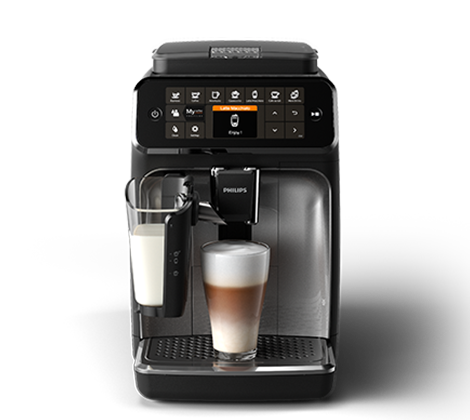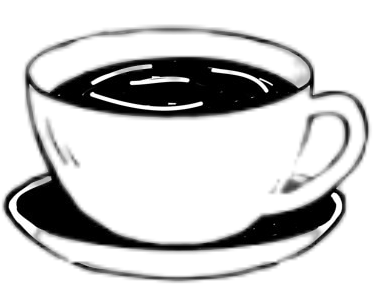#1: Philips 3200

- Easy to use
- Affordable
- Compact design
#2: Philips 4300

- More drink options
- Intuitive touchscreen
- Customizable settings
I first set my eyes on the Philips 3200 vs 4300, I was eager to find out which one would truly fit my coffee needs. Both machines promised to deliver a café-like experience at home, and I was ready to put them to the test. The unboxing experience for both machines was similar—sleek designs, modern interfaces, and a solid feel. However, the Philips 3200 caught my attention with its straightforward controls and intuitive layout. It felt approachable, almost like it was designed for someone who just wanted to enjoy good coffee without the fuss.
Philips 3200 vs 4300: Core Features and Similarities
Diving into the core features, I quickly discovered that both machines shared several important elements. They come equipped with ceramic grinders, which are known for their longevity and consistent performance, making them a great choice for daily use. The AquaClean water filter system is a lifesaver; it significantly reduces the need for descaling, ensuring that you can enjoy your coffee without frequent maintenance interruptions.
Both models also offer five types of drinks, including espresso and cappuccino. This variety allows users to experiment with different coffee styles, and as someone who enjoys switching between drinks based on my mood, I appreciated this feature.

Customization Options in Philips 3200 vs 4300
As I continued to explore, I found that the Philips 4300 does offer more advanced customization options. With the ability to create two user profiles and an Americano setting, it certainly has its perks, especially for households with multiple coffee aficionados. However, I found that the Philips 3200 adequately met my needs with its adjustable strength, temperature, and milk froth levels. For casual coffee drinkers like myself, the added complexity of the 4300 felt unnecessary.
Philips 3200 vs 4300: Milk Frothing Performance
it came to frothing milk, I was impressed by both machines. The LatteGo milk system performed beautifully, creating smooth, frothy milk for my cappuccinos and lattes. What I particularly enjoyed was how easy it was to clean—just a quick rinse and I was done. For anyone who loves milk-based drinks, both machines deliver on texture, but if you’re looking for an effortless cleaning process, the LatteGo system is a winner.
User Experience: Philips 3200 vs 4300
Using the Philips 3200 was a breeze. The touchscreen interface was intuitive, allowing me to select my desired drink quickly. I appreciated how the menu was straightforward, with clear icons that made navigation easy even in the morning haze before my first cup of coffee.
The Philips 4300, while slightly more complex due to its additional settings, can feel overwhelming if you’re not interested in those extra features. I realized that I preferred the simplicity of the 3200 for daily use. The controls on the 3200 were responsive and made it easy to customize my coffee to my liking without diving into a labyrinth of settings.
Cleaning and Maintenance in Philips 3200 vs 4300
Cleaning both machines was a major consideration for me. With the AquaClean filter and easily removable brew group, the Philips 3200 made routine maintenance quick and straightforward. The LatteGo system’s simple design meant fewer parts to worry about, and I could quickly rinse it under running water.
The Philips 4300 also featured easy-to-clean components, but in my experience, the 3200’s more straightforward design lent itself to a less time-consuming cleaning routine. For busy mornings, that can make a significant difference.
Philips 3200 vs 4300: Price Comparison and Value
Price was a critical factor in my decision-making process. The Philips 3200 is generally more affordable than the 4300, and for the features it offers, it provides excellent value. I considered what I was getting—a reliable machine that produced great coffee without the extra complexity—the 3200 quickly became my go-to.
Philips 3200 vs 4300: Energy Efficiency
Energy efficiency is often overlooked, but I found that both machines had automatic shut-off features. This was comforting to know, especially on those busy mornings when I might forget to turn off the machine after my last cup. I appreciated the ability to adjust the shut-off time according to my routine, which further enhanced the convenience of both machines.

My Coffee Experience with the Philips 3200
Having used the Philips 3200 for a while now, I can confidently say that it has elevated my home coffee experience. The consistent quality of espresso shots is commendable, and I enjoy the rich flavors it extracts from various beans. I’ve experimented with different grind settings and coffee strengths, and I love that I can cater my drink to my preferences on any given day.
The ease with which I can switch from an espresso to a creamy cappuccino has made mornings more enjoyable. I’ve even started inviting friends over for coffee, confident that I can whip up their favorites quickly and effortlessly.
Use Cases for the Philips 3200
The Philips 3200 fits well into various lifestyles. For busy professionals, the ability to prepare high-quality coffee in minutes is a significant advantage. For families, the range of drink options can satisfy multiple tastes without needing different machines. And for coffee enthusiasts who enjoy exploring flavors, the customization options allow for plenty of experimentation.
The Bottom Line: Philips 3200 vs 4300
In comparing the Philips 3200 vs 4300, my preference leans toward the 3200. While the 4300 has additional features, I found that they didn’t enhance my overall experience significantly enough to justify the higher price. The Philips 3200 delivers high-quality coffee, easy maintenance, and a user-friendly interface—qualities that resonate with someone like me, who appreciates efficiency without sacrificing taste.
If you’re in the market for a reliable superautomatic espresso machine that delivers on quality and ease of use, the Philips 3200 stands out as a strong contender. It’s a solid investment for both casual coffee drinkers and those who take their brewing seriously.

Frequently asked questions and answers for the Philips 3200 vs 4300 comparison:
Q: What are the main differences between the Philips 3200 and 4300?
A: The main differences between the Philips 3200 and 4300 lie in customization and features. The 4300 offers additional drink options, including an Americano setting, and supports two user profiles for personalized settings. The 3200 provides sufficient customization for most users, including adjustable strength, temperature, and milk froth levels, making it simpler to use.
Q: Which machine is better for a family with varying coffee preferences?
A: If your family has diverse coffee preferences, the Philips 4300 might be the better choice due to its two user profiles and additional drink options. However, the Philips 3200 also offers a good variety of drinks and allows for some customization, making it suitable for most households without the complexity of the 4300.
Q: How does the milk frothing system compare between the two models?
A: Both the Philips 3200 and 4300 feature the LatteGo milk system, which produces rich, creamy froth for lattes and cappuccinos. There is no significant difference in frothing performance between the two models; both are easy to clean and maintain, making them excellent choices for milk-based drinks.
Q: Is there a noticeable difference in coffee quality between the Philips 3200 and 4300?
A: No, both machines produce high-quality coffee with rich flavors and good crema. The differences in customization options do not affect the overall quality of the coffee. Therefore, you can expect similar coffee output from both machines.
Q: Which machine is easier to clean and maintain?
A: Both the Philips 3200 and 4300 are designed for easy cleaning and maintenance. They feature removable brew groups and automatic descaling reminders. However, the 3200’s simpler design may make it slightly easier to maintain for those who prefer a no-fuss experience.
Q: What is the price difference between the Philips 3200 and 4300?
A: The Philips 3200 is generally less expensive than the 4300. The price difference is attributed to the additional features and customization options available in the 4300. If you’re looking for a budget-friendly option, the 3200 offers excellent value for its capabilities.
Q: Are both machines energy efficient?
A: Yes, both the Philips 3200 and 4300 are energy efficient, featuring automatic shut-off functions. This means they will turn off after a set period of inactivity, helping to save energy and ensuring safety in your kitchen.
Q: Can I use pre-ground coffee in both machines?
A: Yes, both the Philips 3200 and 4300 have a bypass doser that allows you to use pre-ground coffee. This feature is particularly useful for those who enjoy flavored or decaf coffee without needing to empty the bean hopper.
Q: How do the grinders in the Philips 3200 and 4300 compare?
A: Both models are equipped with ceramic grinders, known for their durability and consistent grinding performance. They are designed to last up to 20,000 cups without significant wear, providing excellent coffee quality for daily use.
Q: Which model is more suitable for casual coffee drinkers?
A: The Philips 3200 is more suitable for casual coffee drinkers due to its simplicity and ease of use. It offers sufficient customization and a range of drink options without the complexity of advanced features that may overwhelm less frequent users.
